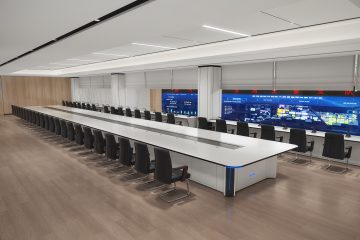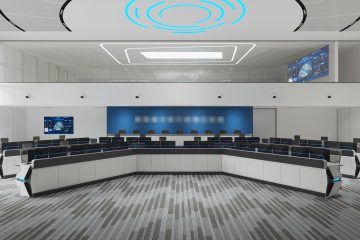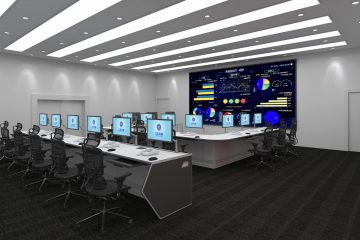Click me to visit our new website
Collaboration:
Security command centers typically involve multiple personnel working together to monitor and respond to security incidents. Multi-user workstation console allow multiple operators to sit nearby, facilitating easier and more effective collaboration, communication, and information sharing. This collaborative environment is crucial for rapidly and cohesively responding to security incidents.
Effective Space Utilization:
Security command centers often have limited space, and multi-user workstation consoles help optimize the use of this space. Shared consoles eliminate the need for individual workstations for each operator, saving space and being more cost-effective.
Centralized Monitoring:
Multi-user workstation consoles can host various monitors and displays, enabling operators to view multiple security cameras, alarms, access control systems, and other critical information on a single workstation. This centralized monitoring enhances situational awareness and helps operators make informed decisions.
Ergonomic Design:
These consoles are typically designed with ergonomics in mind, providing adjustable seating and monitor positions to reduce operator fatigue during long shifts. Ergonomic considerations are crucial for maintaining operator focus and comfort, especially in high-pressure security environments.
Cable Management:
Multi-user workstation console often come with integrated cable management systems, helping to keep the workspace orderly and tidy. Neat and organized workstations are essential for ensuring efficient operations and avoiding issues related to cables.
Equipment Integration:
These workstation consoles are designed to accommodate various security hardware, such as computer systems, communication devices, and control interfaces. This integration streamlines the setup and maintenance of technical infrastructure within the command center.
Redundancy and Failover:
Security command centers require high reliability and uptime. Multi-user workstation consoles can be configured with redundancy and failover capabilities to ensure smooth operation in the event of hardware or system failures.
Security and Access Control:
Multi-user command workstations typically include security features such as biometric access control, authentication, and locking options to protect sensitive information and control access to the command center.
Scalability:
With evolving security requirements, command centers can easily adapt by adding or reconfiguring workstations within the existing layout. This scalability is essential for accommodating changes in personnel configuration or technological requirements.
In summary, using multi-user workstation consoles in the layout of a security command center is crucial for creating an efficient, collaborative, and well-organized environment where security personnel can effectively monitor, respond to, and manage security-related activities. It promotes situational awareness, ergonomic comfort, and adaptability to evolving security needs.



0 Comments